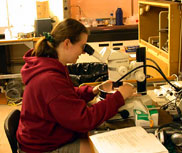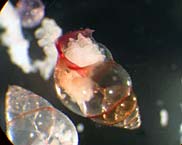|
|
||||||||||||||||||||||||||||||||||||||||||||||||||||||||||||||||||||||||||||||||||||||||||||||||||||
 |
||||||||||||||||||||||||||||||||||||||||||||||||||||||||||||||||||||||||||||||||||||||||||||||||||||
|
May 13, 2003 -- Biological Communities at Lost City: From Microscope to Macrofauna
As we reach the last couple dives of the cruise, people are beginning to get anxious; anxious about getting as many samples as they can before Alvin drops the ascent weights for the final time, anxious about seeing their families again, anxious about finishing up their first few rounds of analysis and their dive reports. Yet each day continues to be full of surprises, discoveries, and excitement. We've collected lots of rocks and water samples and the ABE crew has worked hard making extremely detailed maps of the seafloor terrain. We biologists are now trying to gather the last few samples needed to fully characterize the various animal communities that inhabit the Lost City. Today, Mike Jakuba and I are taking the hydraulic slurp sampler down to sample some newly found actively venting areas. We are hoping for a good biology haul from at least 5 specific chimneys where we have good fluid chemistry samples. With both animals and water chemistry information for the same place, we can compare the composition of the animal communities with the chemistry of the fluids in hopes of understanding which animals thrive in different chemical habitats.
Our last hydraulic slurp dive was very successful. We slurped up one of the many fish seen at the site, and upon getting it to the surface found it was a beautiful lavender bellied eel that is actually found throughout the world. We have also spent hours picking through the samples filled with pieces of carbonate rock that resembles shredded coconut, searching for tiny little snail shells, swarming crustaceans, worms, and even spiders- none of which are larger than half an inch or so.
Each dive brings up something that we haven't seen before, or we discover something new and interesting about things that we saw the day before. Our sieved samples often look like a mass of rock fragments, but once under the microscope we find a tangle of nematode worms, ostracods (flea-like crustaceans) the size of a pin head, or very small stomatopods (shrimp-like crustaceans) that are actually living in tubes made from tiny pieces of foram and snail shells glued together. In fact almost all the animals living in this hydrothermal venting area are very small. If you could see an anatomy diagram of some of them, you wouldn't believe they could exist.
So, many of us anxiously await the end of the cruise, even though it has been a fantastic research experience. For me, it would be to see my one-year old daughter again. While I have been away, she's had her first birthday and went from taking her first steps to learning how to walk all around the house. Unfortunately, I'm on the next cruise as well, so it will be an even longer wait until I am able to stroll in the yard with my daughter. Despite some of the sacrifices we have to make, we are all aware of the awesome opportunity and privilege we seize by learning more about life on our planet and the amazing amount of science that we have accomplished in our time out here. |
||||||||||||||||||||||||||||||||||||||||||||||||||||||||||||||||||||||||||||||||||||||||||||||||||||




